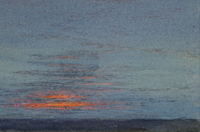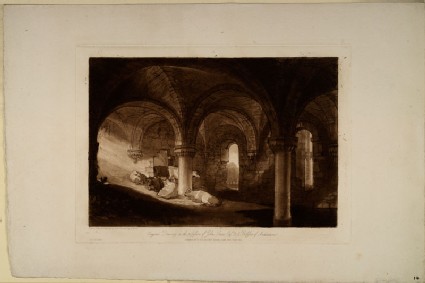Ruskin's Educational series, 1st ed. (1871)
Ruskin's first catalogue of 300 works for the instruction of undergraduates and his notes on the use of particular examples.

Ruskin's Catalogues: 1 object
Show search help- Reference URL
Actions
Crypt of Kirkstall Abbey (from the Liber Studiorum) Turner
-
Ruskin text
62 Kirkstall Abbey. ( Turner’s Liber Studiorum). E -
Details
- Artist/maker
-
Turner (Joseph Mallord William Turner) (1775 - 1851) (designer, etcher, engraver)
- Object type
- Material and technique
- engraving and mezotint on paper
- Dimensions
- 210 x 292 mm (plate); 299 x 450 mm (sheet)
- Associated people
-
Turner Joseph Mallord William Turner (1775 - 1851) (publisher)
- Associated place
-
- Europe › United Kingdom › England › West Yorkshire › Leeds › Leeds › Kirkstall › Kirkstall Abbey › Kirkstall Abbey (subject)
- Inscription
- Recto:
within the plate-mark, all etched:
top centre: A
bottom left: Drawn Etched & Engraved by I.M.W. Turner Esqr. R.A. P.P.
just below: A
just below: 23 Ins. by 36 Ins.
bottom centre: Original Drawing in the possession of John Soane Esqr. R.A. Professor of Architecture | Published Feby. 11. 1812, by I.M.W. Turner, Queen Ann Street West
Bottom right, in ink: 14
- Provenance
-
Presented by John Ruskin to the Ruskin Drawing School (University of Oxford), 1875; transferred from the Ruskin Drawing School to the Ashmolean Museum, c.1949.
- No. of items
- 1
- Accession no.
- WA.RS.ED.112
-
Subject terms allocated by curators:
Subjects
-
References in which this object is cited include:
References
Ruskin, John, Catalogue of the Educational Series (London: Smith, Elder, 1871), cat. Educational no. 62
Ruskin, John, Catalogue of the Educational Series (London: Spottiswoode, 1874), cat. Educational no. 112
Ruskin, John, ‘Educational Series 1878’, 1878, Oxford, Oxford University Archives, cat. Educational no. 107
Finberg, Alexander J., The History of Turner's Liber Studiorum: With a New Catalogue Raisonné (London: Ernest Benn, 1924), no. 39.II
Ruskin, John, ‘The Ruskin Art Collection at Oxford: Catalogues, Notes and Instructions’, Edward T. Cook and Alexander Wedderburn, eds, The Works of John Ruskin: Library Edition, 39 (London: George Allen, 1903-1912), 21, cat. Educational no. 112
Location
-
- Western Art Print Room
Position in Ruskin’s Collection
Ruskin's Catalogues
-
Ruskin's Educational series, 1st ed. (1871)
62 Kirkstall Abbey. ( Turner’s Liber Studiorum). E -
Ruskin's Educational series, 2nd ed. (1874)
112. Kirkstall Abbey. ( Turner’s Liber Studiorum). E -
Educational, manuscript (1878)
112 107.Crypt of Kirkstall Abbey, drawn by Turner, showing the depth of Turner's sentiment fastening, not on the physical, but the moral ruin - Lo, the sparrow hath found her &c. Here, the cattle resting in perfect peace under the sacred vaults, and the last rays of the declining day fading from them, he shows through the arch the quiet trees and river shore that we may know in what sweet places the abbey was built. It is curious that Turner slightly exaggerates the stability, as Prout, monstrously, the ruin of the vaults above; Turner wishing to express their sanctity and therefore their endurance by God's blessing.





